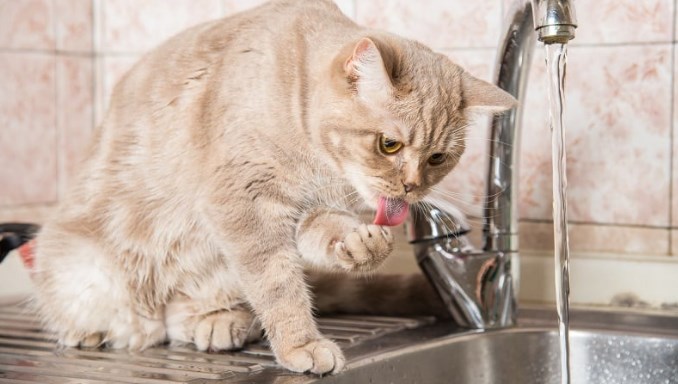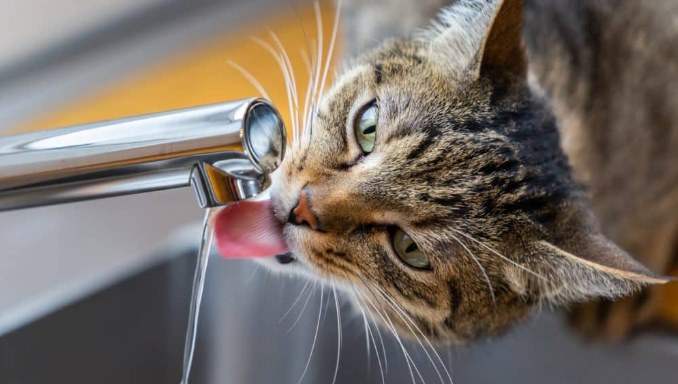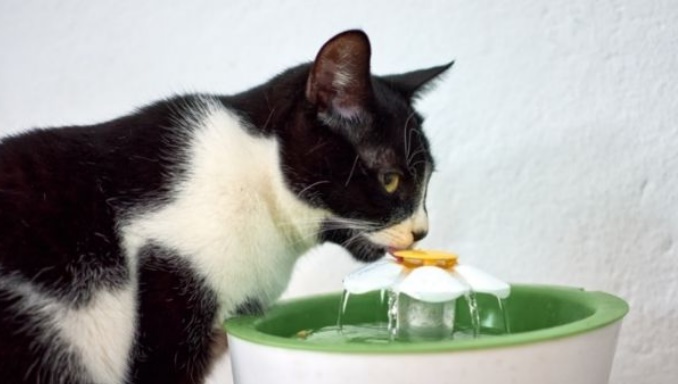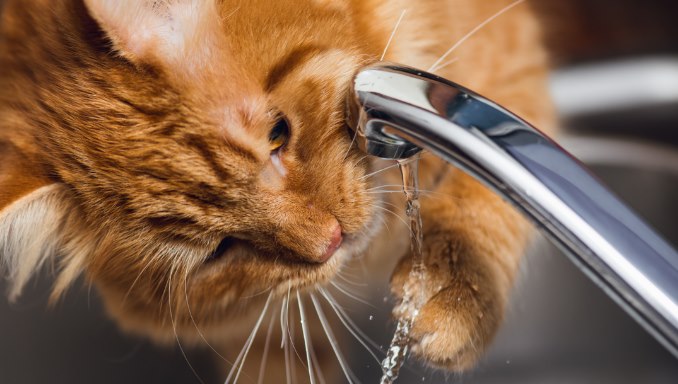How long can a cat go without water? Cats are amazing creatures that can go for long periods of time without water. However, it’s important to remember that cats still need water, and that going too long without it can be dangerous. In this blog post, we’ll explore how long a cat can go without water and what dangers may occur if a cat goes too long without drinking. We’ll also provide some tips on how to ensure your cat always has access to fresh water. So keep reading to learn more!
How Long Can A Cat Go Without Water?
Most cats will drink enough water on their own to stay hydrated, but some may need a little help. If you’re concerned about your cat’s hydration levels, consult your veterinarian. They can check for dehydration and offer advice on how to get your cat to drink more water.
Water is essential for all cats, even those who eat mostly dry food. Water helps cats digest their food, absorb nutrients, and eliminates waste. It also helps keep cats’ bodies temperature regulated.
Cats can go without water for a day or two without any major problems. But if they don’t have access to water for longer than that, they may become dehydrated. Dehydration can cause serious health problems, so it’s important to make sure your cat always has access to fresh, clean water.
If you’re going to be away from home for more than a day or two, ask a friend or neighbor to check on your cat and make sure they have enough water. You can also leave out a few bowls of water in different locations to make sure your cat can always find one.
If you think your cat is dehydrated, contact your veterinarian immediately. Dehydration is a serious medical condition that requires treatment. Your veterinarian will likely give your cat fluids to rehydrate them and may also recommend other treatment options.

Signs Of Dehydration in A Cat
There are several signs that may indicate dehydration in a cat. These include:
-Lethargy or weakness
-Loss of appetite
-Dry mouth or gums
-Panting
-Sunken eyes
If you notice any of these signs, contact your veterinarian immediately. Dehydration can quickly become a medical emergency.
Dehydration in cats can be dangerous if not treated promptly. Dehydration can lead to serious health problems such as kidney disease, liver disease, and even death. If you think your cat is dehydrated, it is important to take them to the vet immediately for treatment. Untreated dehydration can be fatal.
Treating Dehydration in A Cat
Dehydration is a serious condition that can lead to death if not treated quickly and properly. Luckily, it is relatively easy to treat dehydration in a cat at home. Here are a few things you need to do:
1. Give your cat plenty of fresh water to drink.
2. If your cat is not drinking enough water on its own, you can give it small amounts of water or electrolyte solutions through a syringe or dropper.
3. Feed your cat small meals of wet food that are high in moisture content.
4. If your cat is severely dehydrated, it may need to be hospitalized and given IV fluids.
5. Keep an eye on your cat’s condition and call the vet if you see any deterioration. Dehydration can be a serious condition, but it is easily treatable if caught early. Make sure to keep an eye on your cat’s water intake and contact the vet immediately if you think your cat may be dehydrated.

Preventing Dehydration in A Cat
A cat can become dehydrated for a number of reasons, including not drinking enough water, vomiting, diarrhea, fever, and heat exposure. Dehydration can lead to serious health problems, so it’s important to know how to prevent it and how to treat it if it does occur.
Here are some tips for preventing dehydration in your cat:
1. Make sure your cat has access to fresh, clean water at all times. If you’re going to be away from home for more than a few hours, leave out a bowl of water or two so your cat doesn’t have to go without.
2. Add moisture to your cat’s diet with wet food or canned food.
3. If your cat is vomiting or has diarrhea, contact your veterinarian right away. These can cause dehydration quickly, so it’s important to get treatment as soon as possible.
4. Avoid exposing your cat to extreme heat. If it’s hot outside, keep your cat inside in a cool, comfortable place.
5. Know the signs of dehydration. These include lethargy, loss of appetite, dry mouth, sunken eyes, and increased thirst. If you see any of these signs, contact your veterinarian immediately.
Dehydration is a serious condition that can be deadly if not treated promptly. By taking some simple precautions, you can help ensure that your cat stays healthy and hydrated.
Reasons Why Cats Refuse to Drink Water
Some of the typical causes of a cat refusing to drink water include:
Due to the cat’s personality
Cats are also “selective” when it comes to drinking water, they will never touch it if the water is not to their taste. For example, some children like to drink mineral water, while others like to drink tap water, water from the faucet, sink, etc.
Next, the condition of the water bowl will also affect the cat’s ability to drink water. A good example is when the bowl size doesn’t match their body. If it is too small, it will cause the cat to be rubbed and uncomfortable. If it is too big, it will reflect the image of the cat, making it not dare to drink.
The next reason comes from the cleanliness of some cats. If the water bowl is dirty, has garbage, hair, insects, or the drinking place is not clean, they will be afraid and refuse to drink.
Due to health problems
In addition, the cat’s refusal to drink water can also be due to its health reasons. It could be the result of the following problems:
- Blood loss: due to trauma, postpartum, poisoning, blood-related diseases or parasitic infections, helminths, etc.
- Cats in shock: due to an imbalance in the transport of nutrients and oxygen in the body. This causes anemia. Signs that the cat is in shock include: rapid pulse, lethargy, panting, body unsteadiness, gray gums, hypothermia, etc.
- Cat has a fever: you can easily detect a cat with a fever by looking at it. The common signs are that the cat is sad, not eating, lying in one place, breathing fast, often shivering and abnormally changing body temperature.
- Heat stroke: Heat stroke will include symptoms such as rapid breathing, vomiting, lethargy, lack of energy to exercise, and an abnormally high body temperature.
- When you notice the above signs, it is best to take your cat to the veterinary facilities for examination immediately.
Due to the influence of lifestyle
If you have a free-range cat, they may be more picky about drinking water than indoor cats. Because when he went out to play, he drank water somewhere, so he didn’t want to drink anymore when he got home.
In addition, the food will also affect the amount of water your cat needs. Cats who eat seeds will have a greater need for water than babies who eat liquid food.

How to Effectively Treat a Cat That Refuses to Drink Water
When your cat refuses to drink water, apply the following measures:
Adding water to cats in a different way
Instead of forcing your cat to drink water, you can give him foods that contain a lot of water. Typical are liquid dishes, milk, pate and fruit.
Owners can cook for their cats themselves, but I think pate would be the best choice. Because this is the favorite food of most cats and it contains up to 70% water. This not only stimulates the ability to eat, but also provides active water, helps the digestive system work smoothly and the metabolism takes place more efficiently.
Change the position of the cat’s drinking water
Sometimes the area where the water bowl is not satisfied is also the reason the cat refuses to drink water. Therefore, try to change your cat to a new place to drink water that is cleaner and cooler.
It is best to stay away from toilets, cats’ eating places, damp corners, insects, …. Since most cats are thorough, they do not have the habit of eating and drinking and do not want their drinking water to be contaminated.
Clean drinking utensils clean
Cat water containers should be kept as clean as possible. If they detect plaque on the bowl, smelly water in the water, hair, residue, insect corpses, etc., they will immediately hate it.
Therefore, regularly wash the dishes and change the water so that “the emperor” is satisfied and drink more diligently.
Use a tool to stimulate the cat to drink water
No matter how carefully raised and domesticated, cats’ wild behaviors remain. Wild cats from time immemorial have enjoyed drinking from rivers and streams and places with flowing streams. That’s why cats like to drink water from the faucet, from the sink rather than the bowl of water.
Therefore, if possible, the owner can buy a fountain for the cat. This will be an interesting toy, stimulating curiosity and being able to treat cats who refuse to drink water extremely effectively.
Currently on the market there are quite a few cat fountain products with diverse features and prices. Based on your own conditions, choose the most suitable product for your cat!
Put water in many positions and change the shape of the water bowl continuously
Cats often have the habit of walking and exploring around the house. So keep a variety of water bowls of different sizes and shapes around the house. This method makes cats feel more novel, so that sometimes they are not thirsty but they are still curious and drink.
It is best to place the water basin in a clean, easy-to-see location. Especially in places where cats often live, such as sleeping or playing. This can remind and stimulate your cat to drink water more often.
How Much Water Should Cats Drink Each Day?
In addition to how to treat cats that refuse to drink water, owners also need to pay attention to how much they need to give the cat each day.
Experts recommend that an adult and healthy cat drink between 50ml and 60ml of water per 1kg of body weight. This means that when your cat is 5kg, it needs to drink between 250ml and 300ml of water per day.
However, sometimes some external factors can also affect and change this number. It can be the health status, weather, mobility of the cat, etc. Therefore, the owner should observe and learn to adjust the amount of water appropriately!
Cats are really difficult to please, they will not easily obey, even if it is good for themselves. That’s why the owner needs to care and create conditions for cats to change his habits.

FAQs
Can I give my cat water with a syringe?
Yes, you can. If your cat refuses to drink water and you are very worried, you can use a syringe to give it water. But this is only a short-term measure, not a long-term solution. Because when the tube is put in the mouth, the cat will be scared and uncomfortable, making it more difficult to drink water in the future.
Should I give my cat ice water?
No, you shouldn’t. Because when cats eat or drink too cold water, it will cause gastrointestinal discomfort and vomiting. In addition, giving your cat ice water is not a good way to encourage it to drink more water.
How do I get my cat to like drinking water?
You should put the water in many positions and change the shape of the water bowl continuously. Cats often have the habit of walking and exploring around the house. So keep a variety of water bowls of different sizes and shapes around the house. This method makes cats feel more novel, so that sometimes they are not thirsty but they are still curious and drink.
It is best to place the water basin in a clean, easy-to-see location. Especially in places where cats often live, such as sleeping or playing. This can remind and stimulate your cat to drink water more often.
In addition, you can buy a fountain for the cat. This will be an interesting toy, stimulating curiosity and being able to treat cats who refuse to drink water extremely effectively.
Will a dehydrated cat urinate?
No, dehydrated cats will not urinate. Because when the body lacks water, it will first use it to maintain basic life activities such as heartbeat and respiration. So if you see your cat’s urine is dark yellow or even brown, you should take it to the vet immediately for examination and treatment.
Can a cat recover from severe dehydration?
Yes, cats can recover from severe dehydration. But if it is not treated in time, it will be very dangerous and even life-threatening. Therefore, when you see the signs of dehydration in your cat, you should take it to the vet as soon as possible for proper treatment.
What are the signs of kidney failure in cats?
There are a few different signs that may indicate kidney failure in cats. These can include increased thirst, urination, and appetite; weight loss; and vomiting. If your cat is displaying any of these symptoms, it’s important to take them to the vet for an evaluation as soon as possible. Kidney failure can be a serious condition, so early diagnosis and treatment is essential.
What Can Cats Drink Besides Water?
There are a few different things that cats can drink besides water, such as milk, juice, and even some types of beer. However, it is important to note that not all of these beverages are necessarily good for cats and some can even be downright dangerous. As such, it is important to consult with a veterinarian before giving any type of non-water beverage to a cat. In general, however, water is still the best choice for cats and should always be available to them.
Cats can drink milk, but it’s not the best choice for them. Milk contains lactose, which is a sugar that cats cannot digest. This can lead to diarrhea and other digestive problems. Cats also like to drink water with a little bit of milk in it, but again, this is not the best choice for their health.
Conclusion
Although cats are able to go without water for a longer period of time than dogs, it is still important that they have access to fresh water at all times. By understanding how long cats can go without drinking water, you can be better equipped to make sure your cat stays healthy and hydrated.
If you are concerned about your cat not drinking enough water, consult with your veterinarian. They may be able to suggest a way to help increase your cat’s water intake. Have you ever wondered how long can a cat go without water? Let us know in the comments!









Reading your article helped me a lot and I agree with you. But I still have some doubts, can you clarify for me? I’ll keep an eye out for your answers.